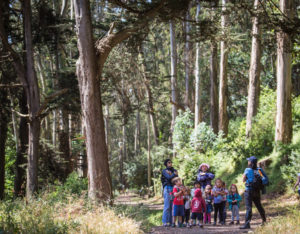It’s lunchtime at Hidden Villa, and a cluster of hungry children suspiciously eyes a “garden burrito” filled with beets, flower blossoms, and apple, all wrapped in green sorrel leaves.
Meagan Stewart, 8, takes a big bite, giggles, and decides to use the beet to decorate her face with bright red juice.
On the other edge of the valley, teenagers pick organic squash for pizza–gaining an appreciation for food production unavailable at the corner 7-11. “It’s hard. They’re heavy. Things poke your hand,” sighs Marcelo Sotelo, 15, of Redwood City.
These urban youth have come to this idyllic setting–carefully cultivated bottomland nestled in the eastern foothills of the Santa Cruz Mountains–to learn an agricultural ethos far removed from the industrial-scale monoculture that yields most supermarket food.
A “farming with the wild” philosophy–that small-scale agriculture can fit the land, feed the soul, enrich the intellect, and support social justice–has been at the heart of this 1,600-acre farm and open space park on the Peninsula for 67 years.
“It’s such a respite. There’s no noise, above the human voice. You can go at a human pace, not a Silicon Valley pace,” says Carol Espinosa of Portola Valley, a longtime donor who first visited in the early 1970s.
- http://jfb.smugmug.comThree young pigs feast on vegetable and fruit scraps. The farm keeps livestock, including pigs, cows, goats, sheep, and chickens. Photo by Joel Bartlett, jfb.smugmug.com.
Founders Frank and Josephine Duveneck conceived of Hidden Villa as a gathering place for discussion, reflection, and incubation of social reform. Themes of fairness and equality are woven into the lessons on agriculture and ecology taught by the independent nonprofit that now runs the preserve.
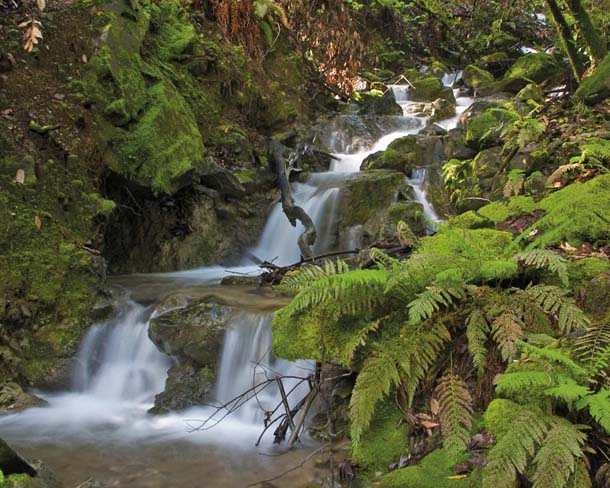
- Adobe Creek in winter. Hidden Villa founders Frank and Josephine Duveneck first bought the land to protect Adobe Creek’s headwaters. Photo by Joel Bartlett, jfb.smugmug.com.
It is a fitting place to celebrate the bounty of early spring, as rains recharge Adobe Creek, pastures turn a velvety green, and remnant orchards explode into bloom. Happy to be liberated from classrooms, slicker- and boot-clad children explore the farm and surrounding woods–pulling a carrot from the soil and searching leaf litter for banana slugs and mushrooms.
There are lessons for the public as well. On wet days, visitors might gather around a fireplace to taste fresh mozzarella and goat-milk chevre, made on site. There might be bread-baking classes or ham-cooking lessons.
As days lengthen and temperatures climb, it’s time to look for wildflowers on the preserve’s many trails, watch squirming baby piglets in the barn, or see sheep get their annual haircut on Sheep Shearing Day.
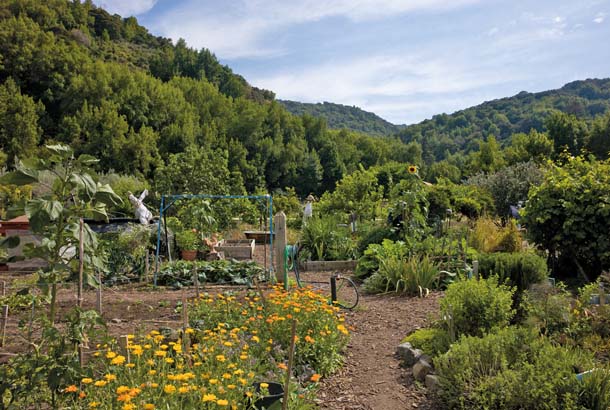
- Organic vegetable garden beds at Hidden Villa, with the forested hillsides of the Santa Cruz Mountains beyond. Photo by Joel Bartlett, jfb.smugmug.com.
For quiet recreation, visitors can hike the park’s trail system through the Adobe Creek watershed. Several easy-to-moderate loop trails traverse oak woodlands, chaparral, and grasslands. By March, this creek will be a maternity ward for California newts.
The farm’s rich alluvial soil comes from the steep flanks of nearby hillsides, rinsed down by the creek and its related tributaries in the 11-square-mile watershed. Just a thin blue trace on a map, Adobe Creek springs from the northeastern face of Black Mountain and trickles more than 14 miles through Los Altos Hills, Los Altos, and Palo Alto on its way to join the Bay. The founders of Adobe Systems, the global software giant, lived nearby and named their company after the creek.
Long before that, Ohlones lived along the creek’s banks. Archaeologists say the valley was marshier then; the Native Americans would have likely fished in the creek, gathered bunchgrasses in the valley for weaving baskets, hunted deer, and gathered acorns in the hills. The nearest known pre-European Ohlone settlement, excavated in 1971, is on El Monte Road at Summerhill Avenue.
With the arrival of Europeans, the land was valued largely for what residents could extract from it. In the 1700s, missionaries planted vineyards and olive groves. An elegant grove of ancient Italian olive trees still stands today–look for them, on the right, as you enter from Moody Road.
Later, mill owners harvested Douglas firs and redwoods for lumber, and, in the 1880s, the property served as a rest stop between the then-bustling port of Pescadero and the Mountain View train station. (The current driveway is a remnant of the old Moody Road stage road; look for a hitch on an ancient oak tree.)
The two oldest buildings on the property, from this era, are the old white ranch house–built in New England, then reportedly shipped around the Horn–and the white barn, originally assembled with dowels rather than nails.
In the 1890s, speculators sought to dam the creek to provide water for the burgeoning population and thriving orchards. In 1904, the army tried unsuccessfully to purchase the land for a shooting range.
Finally, the valley was saved–and its focus shifted to sustainability–in a foreclosure sale of 1,000 acres to Frank B. Duveneck in 1923 for a reported $10 in gold coin and a $20,000 mortgage.

- Josephine Duveneck at the wheel in 1947 with kids from Hidden Villa’s summer camp, which was founded in 1945 as the region’s first interracial and multicultural camp. Photo courtesy Hidden Villa.
It seemed an improbable match; Frank and Josephine Duveneck, newcomers to California, descended from prominent Boston families. She traced her bloodlines back to the erudite and wealthy Whitney family and had studied at both Radcliffe and Oxford. He was a Harvard graduate and the son of a noted painter, yet also a genuine Renaissance man, whose roles ranged from electrician and woodworker to pianist, poet, and photographer.

- A ewe and two lambs. The farm holds an annual sheep-shearing day each spring. Photo by Joel Bartlett, jfb.smugmug.com.
The Duvenecks were also avid environmentalists and nature lovers. “In California we encountered completely different species,” Josephine recounted in her 1978 autobiography. “We spent many evenings identifying specimens we brought back from trips. I am sure no other source of recreation is as satisfying and no other remedy for overburdened minds and frazzled nerves is as effective as getting away from routine into the untrammeled wilderness.”
They spotted the valley one weekend as they drove up Page Mill Road from Palo Alto in their Model T, en route to a campsite in the mountains.
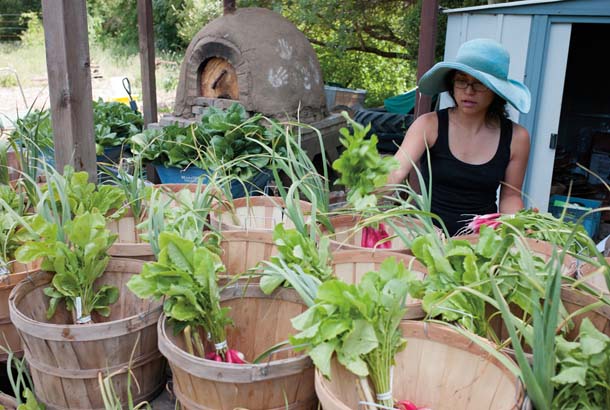
- Sorting radishes for Hidden Villa’s community-supported agriculture program, which provides subscribers with weekly baskets of produce from May through November. Photo by Joel Bartlett, jfb.smugmug.com.
At first, they visited the ranch only on weekends. Josephine was busy serving on the City Council in Palo Alto and founding Menlo Park’s Peninsula School. Frank was a Stanford engineer and physicist and invented an x-ray apparatus.
Their initial goal was to protect the headwaters of Adobe Creek. Recognizing the importance of owning land to protect a watershed, they gradually added to their holdings, which eventually encompassed 2,500 acres.
They moved to the ranch full-time in 1930, after remodeling the old ranch house, expanding the original three rooms to seven. Later, they built the present Duveneck home–dubbed “The Big House.” The couple acquired a goat and several horses and opened the green iron gates of Hidden Villa to hikers and equestrians.
“There were no fences. We could ride our horses over property lines and no one objected,” wrote Josephine.
As Christmas approached, they hiked into the wintry hills to collect bundles of bay, wild cherry, and toyon branches, then wove the greenery into hoops to make wreaths.
Over the following decades, the couple made history by establishing the first hostel on the Pacific Coast (1937) and the first interracial and multicultural summer camp (1945). After World War II, they offered interned Japanese Americans a place to get back on their feet.
Later, their dining room table was where Cesar Chavez and a small group of Mexican Americans planned “La Huelga,” the first major farmworkers’ strike and grape boycott. At a lunch along Adobe Creek, the Loma Prieta chapter of the Sierra Club was founded; a metal tablet commemorates the spot where the inception took place.
“They took positions on social issues that today would be ‘no-brainers’–but at the time seemed so improbable,” wrote Nan Geschke, a longtime volunteer at the Los Altos History Museum, who gathered photos, documents, books, and other historical memorabilia for the museum’s Duveneck exhibit in early 2011.
As the valley grew crowded with suburban development, the secluded ranch and its wilderness grew increasingly popular. “What had been a trickle of visitors developed gradually into a steady stream,” Josephine wrote. To help support it, in 1960 the nonprofit Trust for Hidden Villa was created.
The next generation–children Francis, Hope, Liz, and Barney–could have cashed in when their parents died, but they donated the ranch and natural areas to the trust, which manages the property and its innovative programs.
“They left a legacy based on social justice–how to be stewards of one another, and of the natural world,” says Garth Harwood, Hidden Villa’s environmental education director.
They also left another inheritance that is now part of a large swath of contiguous open space and wildlife habitat, linked to Rancho San Antonio and Monte Bello open space preserves.
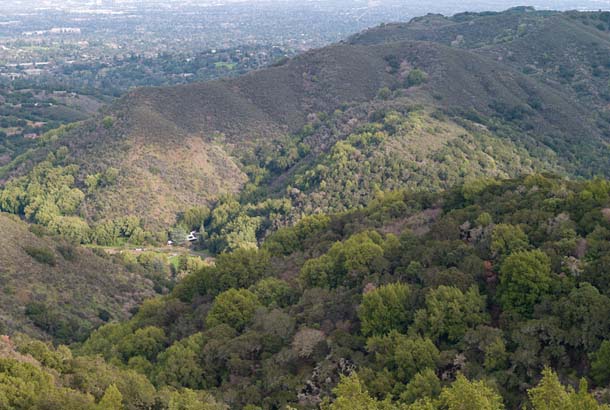
- Hidden Villa is nestled at the foot of the Santa Cruz Mountains. Trails extend up into wilder areas and on into adjacent preserves owned by the Midpeninsula Regional Open Space District. Photo by Joel Bartlett, jfb.smugmug.com.
Today, Josephine’s Hidden Villa Summer Camp is still flourishing. Attendance has grown to 1,200 campers annually; many are on scholarship. There are eight different programs, from day camps focused on food and fun for little ones to two-week “Bay to Sea” hiking and camping adventures for teens.
Youth development program coordinator Bill Dudley jokingly describes a newer year-round teen program as “X-Box Detox.” He adds, “I use the natural world to develop principles that work across life. We practice sitting under a bay tree for 20 minutes, and it’s very silly when they start. But after 20 minutes, they don’t want to leave.”
In the gardens, Dudley works to change students’ attitudes about nutrition, food prices, and labor. A long afternoon with the crops, he says, “brings awareness and appreciation of the value of organic food.” Supermarket prices do not reflect labor’s real worth, he tells students. “If they did, farmworkers could live a decent life.”
Hidden Villa’s own farm produce addresses such problems directly: Most of it goes to members of the farm’s Community Supported Agriculture program, low-income Mountain View residents, or the Los Altos Farmers Market.
Farm, field, and forest are also the setting for programs and field trips sponsored by Hidden Villa’s Environmental Education Program. Operated by four staff members and 50 community volunteers, the programs help about 22,000 students every year learn about animals and gardens. They might sneak up on a browsing deer, learn the parts of a plant, milk a cow, or discover an old junco nest. Older students help with stream restoration, trail maintenance, plant propagation, or garden design.
“We’ve been a gateway to fall in love with nature for hundreds of thousands of children,” says Harwood. “When children feel a kinship with nature, they’ll be eager to collect knowledge.”
You can also visit Hidden Villa to hike on your own. On cool winter or spring days, the Hostel, Grapevine, and Toyon trails are full of sunshine and blooming chaparral shrubs. If it’s warm, hike beneath scaly western sycamores or fragrant bay laurels along the moist Adobe Creek Trail. Or try the Bunny Creek Loop Trail–nicknamed for the ephemeral North Fork of Adobe Creek –which ascends one small ridge and then descends back into the ranch.
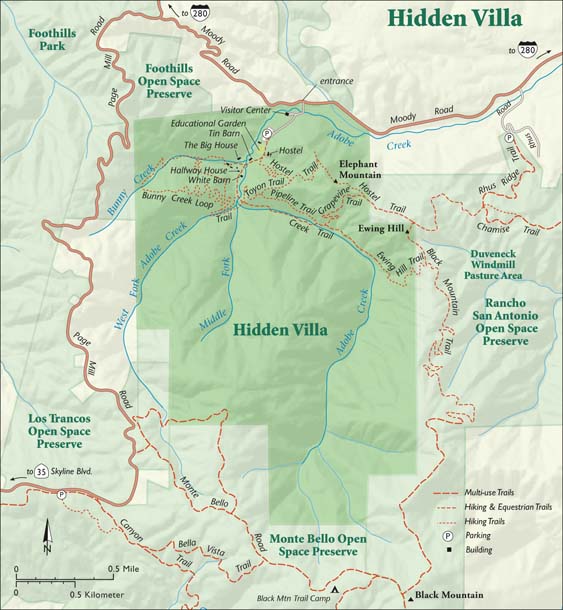
- Map by Ben Pease. Click for larger version.
For more ambitious outings, there’s the Black Mountain Trail, 3.5 miles and 2,300 feet up to the summit of Black Mountain in Monte Bello Open Space Preserve. Or take the Hostel Trail over Elephant Mountain and on to the Duveneck Windmill Pasture Area of Rancho San Antonio Open Space Preserve.
“It is a wonderful place to experience nature,” says former Peninsula Open Space Trust director Audrey Rust, glowing with perspiration and good spirits after ascending the Black Mountain Trail, which she calls “the best trail on the Peninsula.”
Listen: A Steller’s jay cries. A cow moos. In this open-air classroom, nothing separates farming and the wild.
Bill Dudley watches the urban teenagers in his class jostle for a chance to pour organic tomato sauce onto freshly baked crust. Here, he hopes, are the seeds of a revolution in social conscience.
“You can’t see whose trajectory you are changing,” he says. “The legacy of the Duvenecks was not just preserving and observing, but being active agents. We take an active role in change.”
Getting There:
Take Interstate 280 south to El Monte/Moody Road. Take El Monte west. Pass Foothill College and proceed to the stop sign with a small “Hidden Villa” sign across the street. Turn left on Moody, go 1.7 miles and go left at 26870 Moody Road. Parking is $5 (fee waived for program attendees). Hidden Villa is closed Mondays; bikes are not allowed.
Learn more at hiddenvilla.org.

.jpg)




